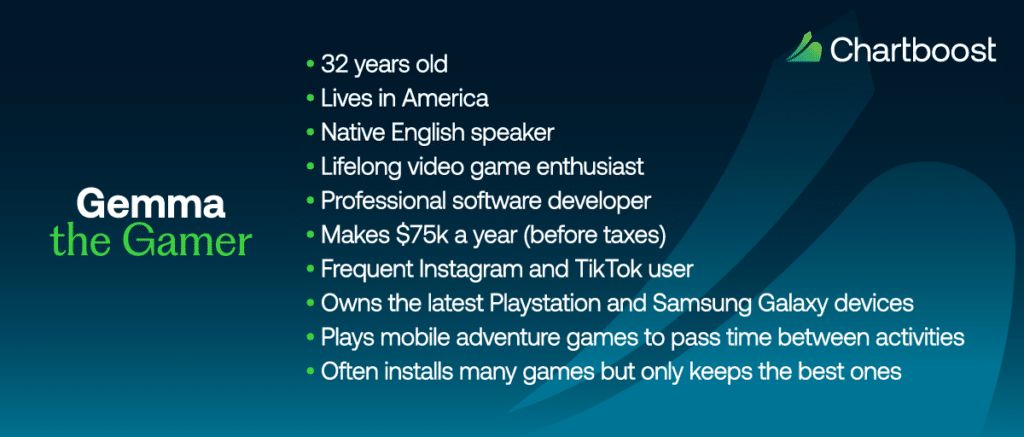You had a great idea for a mobile game. Then you hired a team of top-level professionals to make it a reality. Now you have a killer product that your target audience will love.
But none of it matters if you don’t build an effective user acquisition (UA) strategy.
Think about it: there are hundreds of thousands of other games in the app stores, each vying for attention. Marketing costs have exploded in recent years. User loyalty has never been more fragile. The only way to succeed in this environment is to develop a solid UA plan.
Read on to learn what user acquisition is, why it matters, and how to develop a UA strategy in five simple steps.
What is user acquisition and why does it matter?
Let’s start with a definition:
User acquisition is the process of acquiring new users for your mobile game(s). It can be accomplished through a variety of marketing channels and activities.
Some channels and activities revolve around ad networks, social media, and app store optimization (ASO). We’re taking a closer look at the two kinds of UA available to mobile game developers like you. We’re talking about paid and organic UA.
- Paid UA: An approach to user acquisition in which mobile game marketers use paid ads to attract and convert potential users into actual users who drive revenue. Most paid UA happens via social media platforms and ad networks (though not always).
- Organic UA: An approach to user acquisition in which mobile game marketers do not use paid ads to attract and convert users. Rather, marketers work to improve the discoverability of their game(s) via ASO, smart use of social media, and other tactics.
Paid UA will help your game(s) stand out in a crowded marketplace and achieve results in less time. Organic UA is a long-term approach that will improve your future. Plus, it’s free!
At Chartboost, we believe that most mobile game developers should use a combination of paid and organic UA strategies. Doing so will help you achieve all of the benefits of UA, including growing a larger user base and achieving higher revenue numbers over time.
How to build a winning UA strategy for your mobile game
Now that we know what UA is and why it’s important, we can focus on the five steps to create an effective UA strategy for your mobile gaming company.
You’ll notice that the steps below combine paid and organic UA strategies. As mentioned, this is the best way to achieve success, both now and into the future. Let’s begin.
1. Learn about your target audience
It doesn’t matter what you sell — mobile games, mountain bikes, or ugly Christmas sweaters. You need to understand your audience if you want to sell to them effectively. So, start there.
Ask yourself questions like, “Who is my target audience?” and “What is their gender, age, and level of disposable income?” and “What do they like about my kind of game?”
Attempt to answer these questions via research rather than gut feelings. Why? Your gut might steer you in the wrong direction. You might think that your target audience should be, for example, teenage boys when it actually should be women in their mid-30s.
Once you’ve completed your research and collected a sizable amount of data, assemble it into a user persona, i.e., a fictional person you create to represent your real-world user base.

2. Supercharge your app store listings
You know who your target audience is. Now you need to update your app store pages to speak to this specific group of users. This process is known as app store optimization.
Proper ASO helps your game rank higher in the Apple and Google Play stores. It also helps improve your game’s conversion rate, which is essential to success in this field.
Here are a few tips to help you crush your ASO efforts:
- Keywords: If you’re unfamiliar with the term, keywords are words and phrases that users type into search engines like the Apple and Google Play stores. Try to populate your pages with high-traffic, low-competition keywords to attract your ideal users.
- App icon: Your app icon is one of the first things people see when they come across your game. Make sure your game’s icon matches your brand, catches the attention of your target audience, and jives with current trends in your genre.
- Images and videos: Your screenshots and promo video may be the most important parts of your game’s app store page. Showcasing game features, mechanics, etc. in a compelling way, and users will be excited to install.
- Call to action: What do you want people to do after they scroll through your app store page? Install your game of course! Your call to action (CTA) shows them the way. Encourage users to download your game at the end of your description.
- Ratings and reviews: Last but not least, pay attention to your game’s ratings and reviews. While you can’t force people to love your game, you can provide every user with a great experience so that they’ll leave glowing reviews on their own.
3. Create high-quality advertisements
Organic UA is awesome, but at some point you’ll need to invest in paid UA. When you do, make sure your ads are high-quality. Fall short, and you’ll be wasting your investment.
Start by choosing the most effective ad format. There are several that work well for mobile games:
- Playable ads: To make sure we’re on the same page, a playable ad allows users to play a section of the advertised game. The best playable ads display key game elements and mechanics. Done properly, playable ads are extremely powerful because they’re so engaging to mobile gamers.
- Rewarded video ads: Generally speaking, video ads are the most effective format for mobile games. It makes sense: video ads allow developers to showcase the full gaming experience. Rewarded videos are particularly potent. Why? Because they incentivize engagement. Users get a prize for watching them.
- Interstitial ads: While usually not as effective as playable or rewarded video ads, interstitials still have their place. These advertisements take up the full screen and are best shown during natural breaks in gameplay, such as when a user’s character dies, completes a level, etc.
- Native banner ads: The best thing about native banners ads is that they can be displayed in a way that makes them look like part of the game. This makes them less disruptive to the user experience. Native banner ads are also easy to make and cost-effective, though they generally don’t produce the same ROI as other ad formats.
Choosing the right ad format is only half of the equation. You need to create high-quality advertisements, too, if you want to find success. To do so, use eye-catching imagery, showcase the best elements of your game, and iterate your approach based on data.
4. Invest in online marketing campaigns
To create a UA strategy that really moves the needle, look beyond one-off ads and invest in full-fledged online marketing campaigns.
Take a look at those user personas you created. Where does your target audience hang out online?
Your audience might be obsessed with Instagram, TikTok, or some other social media network. They might read certain blogs that serve the mobile gaming community. Or perhaps they listen to podcasts that report on the latest and greatest games in your specific genre.
When you know where your target audience is, you can devise ways to reach them. For example, you can hire social media influencers to promote your game on specific channels. Or you can contribute guest posts to popular blogs. Or try seeking interviews on top podcasts.
It probably goes without saying, but make sure your online marketing campaigns relate to your mobile games. You probably shouldn’t hire a fitness influencer, for instance, if you publish RPG games. That influencer might have millions of followers, but his or her audience might not be interested in RPGs, so it would be a waste of your money.
5. Analyze your user acquisition strategy
The final step in creating an effective UA strategy revolves around analysis.
Start by choosing a few key performance indicators (KPIs) to match your UA goals. Want to attract new users without breaking the bank? Track number of installs and cost per install. Want to improve the lifetime value (LTV) of your users? Track session length and retention.
There are a ton of metrics you could track. The trick is finding the ones that will help you reach your goals. Once you identify them, monitor them religiously and adapt as needed.
For example, if your install KPI is subpar, experiment to find better performing ads. If retention is the problem, look for ways to make your game more engaging or offer additional in-game perks.
The point is your UA strategy must evolve. The only way to do so successfully is to track KPIs and use the information they provide to improve your game, the way you market your game, and the plan you use to build relationships with current players.
Acquire more users for your mobile game
There are hundreds of thousands of mobile games in the Apple and Google Play stores. To stand out in this crowded market, you need to build an effective, thoughtful UA strategy.
Fortunately, the five-step process above will help you do just that.
So, what are you waiting for? Take the time to learn about your audience and supercharge your app store listings. Next create high-quality ads, invest in online marketing campaigns, and analyze (and iterate) your UA strategy to achieve greater success.
Does the thought of building or rebuilding a UA strategy from scratch give you the sweats? Don’t worry, Chartboost makes the process easier. Partner with us to target the right users, create uber-effective ads, and quickly analyze performance. We can’t wait to work with you!



